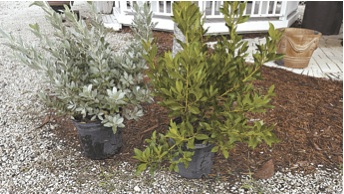Buttonwood is a favorite native grown as a multi-trunk shrub or in standard tree form and comes in both a green variety (Conocarpus erectus) or a silver variety ( Conocarpus erectus var. sericeus). Sometimes referred to as ‘button mangrove’, this plant is often found growing just inland of the white mangroves, along many island beaches. In fact, Buttonwood is in the same family as the white mangrove, black olive and tropical almond. A native of Florida, it is also found naturally on islands from Bermuda and the Bahamas throughout the Caribbean, Mexico, Central and South America, as well as the Galapagos Islands. While this native loves the beach, the buttonwood also does well in inland habitats along the borders of fresh and brackish marshes and along the edges of low hammocks.
Buttonwood is highly salt-resistant, and protects against beach erosion from storm surge. It is also a food source for wildlife. The wood has been used for smoking fish and for firewood. This is a tough plant that grows well in both sandy soil as well as wet, salty conditions, so it is a highly recommended plant for seaside areas. The buttonwood is also used in hedges, buffers and sometimes as a specimen tree in an all native landscape. It will take either full sun or partial shade and does not have a lot of leaf drop which is always nice. Another nice perk, the buttonwood’s rough bark provides an idea environment for attaching bromeliads or orchids out in the landscape.
If you need a native tree or shrub that can put up with tough conditions and still look good, try the green buttonwood or silver buttonwood in your landscape. You will be glad you did.
This plant column is a joint effort by all at In The Garden, a Sanibel garden center located at 3889 Sanibel Captiva Road, Sanibel, Florida.
